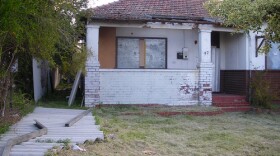Hogs are running rampant in Dallas. That's right -- parts of the nation's ninth-biggest city are beset by a plague of feral pigs. The problem's so bad that last month, the city approved a three-year, $284,000 contract to catch the beasts, which are wreaking havoc on land, especially in the southeast wilds near the Trinity River. So we took a ride with the city's official hog-catcher.
It’s midafternoon and 31-year-old Osvaldo Rojas has loaded up his pickup truck. He's headed to the Great Trinity Forest in Southeast Dallas where he hopes to find some hogs.
Instead he sees signs of them, like a torn up dirt road that doesn’t make for a smooth ride. From the looks of it, the hogs have been hanging out in the mud.
“There’s some wallowing there right on the road,” Rojas says. “Since they don’t have sweat glands, they need to cool down so what they do is cover themselves up with mud as much as they can and keep the sun off them. It keeps them fresh.”
Rojas, who runs City Trapping, says catching hogs is not for the faint of heart. In his 10 years as a trapper, the guy’s seen it all. Like the times he's had to go into a cage to get a hog out.

“I’ve been flipped over between five and seven times. I don’t remember the last two,” he says laughing. “I know I was on the floor when I woke up, so I don’t know if it was a hog because I can’t remember, and that’s a bad thing.”
He’s also caught a lot more than hogs. For example, West Nile Virus.
“Uh, the mild version. The mild version,” he says.
And he’s caught other unpleasant things.
“Spider bites. All the time. Daily,” he says. “Bugs, chiggers. That’s a bad bad bad rash right there.”
Next, he heads to a pond where he thinks there’s a pretty good chance of finding some hogs on a sunny day. It’s clear from the looks of the water, they’ve been here.
“There’s hardly any fish at all,” he says. “The only fish that are in there is when it’s overflows from the river and it’s a couple of gar. But as far as bass, even catfish aren’t in there.”
Rojas is armed with a gun for protection and a camera for capturing the great outdoors. Capturing wild hogs? It’s all about strategy.
Between 1.8 and 3.4 million hogs are estimated to be roaming the Lone Star State.
“We’re gonna walk as slow as we can even if it takes 30 minutes,” he says as he sets out for a trap. He's sure he'll see hogs nearby.
Rojas’ has set up heavy gauge wire traps all over the area that look like oversized dog crates. Another is 30-feet round. Some even have surveillance cameras.
He gets alerts on his phone when the hogs go in overnight. He doesn’t trap them right away though. He spends a couple of weeks getting them used to the cages by luring them with food.
When Rojas reaches one of the traps, he releases some kernels of corn from a metal cylinder.
“We’ll see if they come running,” he says.
But the hogs don’t come running.

Not that there aren’t plenty of ‘em out there. Between 1.8 and 3.4 million hogs are estimated to be roaming the Lone Star State. The animals, which can get up to 400 pounds and have tusks, were introduced to Texas in the 1500s. Jessica Alderson, an urban biologist with Texas Parks and Wildlife says they’re becoming a bigger problem for cities and urban areas causing nearly $52 million in damage to agricultural land.
“In the Dallas/Fort Worth area, we had a lot of calls of hogs coming into neighborhoods and tearing up front yard landscaping overnight,” Alderson says. “They would spend hundreds of dollars fixing their yard and then be woken up the next morning [to find their yard] completely torn apart again.”
The state says there are only a few options for captured hogs. They can be sent to a slaughterhouse. Or the males can go to an approved holding site where they’ll be released and hunted.
Rojas says he loves this job and can’t imagine doing anything else.
“I get paid to do it. It’s not that I’m not looking for thrills. It happens.”
Lots of thrills, but today, at least, no hogs.
“It’s just like fishing. They call it fishing for a reason and not catching,” he says.
For Rojas, the hunt continues.








